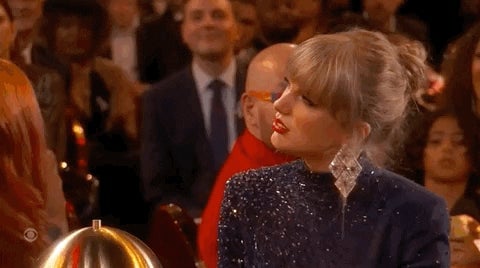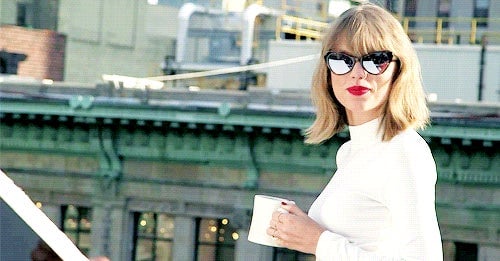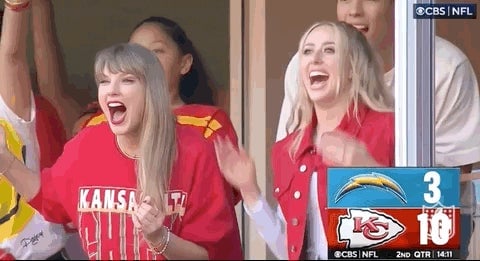The Taylor Swift economy: Red hot
How music’s most iconic name became a GDP star

The Taylor Swift Effect
Suggested Reading
It’s Taylor Swift’s economy, and we’re all just buying into it.
Related Content
In case you were unaware, the 33-year-old singer-songwriter has, among other things: redefined music ownership for artists, shaken up Apple Music and Spotify, sold her documentary Miss Americana to Netflix for $25 million, and even made Indonesia rethink visa rules for performers. Now, she’s taken the silver screen by storm with a record-breaking concert movie about her record-breaking Eras Tour.
Her music sales, streaming hours, concert profits (not just from tickets, but hospitality and tourism, too), and so much more has all, well, swiftly boosted US consumer spending this year.
So how did the country star turned pop star turned billionaire become so influential that she’s helping lift the GDP of the world’s biggest economy? Let’s take you on a tour, if you’re “... Ready For It?”
By the digits: The Eras Tour
$4.1 billion: Taylor’s earnings from the Eras Tour concerts and film, a historical record for a solo artist
$100,000: Bonus each trucker working on Swift’s Eras Tour received, well above the usual $5,000-$10,000
$55 million: Sum of bonuses Swift doled out to cast and crew on the Eras Tour, including to dancers, riggers, sound technicians, catering, video, audio, and lighting workers
$5.7 billion: Boost Swift’s concerts gave to the US economy, not just in terms of tickets, but also costumes, travel, hotels, food, and other ancillary spending
$500-$7,000: Price for an Eras Tour ticket from official resellers like StubHub (they were originally priced between $49 and $499)
Her concert film era begins
After her billion-dollar worldwide Eras Tour, Swift gave her performances a second life with a theatrical release. Pre-sales for Taylor Swift: The Eras Tour concert movie broke Ticketmaster (again), even prompting a bump-up of the movie’s release date by one day in the US and Canada.
Taylor Swift: The Eras Tour shattered several records, including:
🍿 The highest-grossing concert movie of all time, with a $123 million opening weekend
🍿 The highest first-day ticket sales in 2023
🍿 The first concert movie to remain in the top spot at the US box office for two weeks
Of course, this isn’t a sign that just any concert film will succeed, even as studios mull how the format might work for big current artists and other posthumous singers and bands that are no longer touring. In Taylor Swift’s world, production value—in scale, budget, and execution—is just so much bigger. It was filmed over multiple nights at the Los Angeles SoFi Stadium with 40 cameras. Plus, she comes with a massive army of Swifties, ready to splurge on all things Taylor.
Quotable
“I don’t like a gold rush, gold rush / I don’t like anticipating my face in a red flush.” —Taylor Swift in her 2020 song “gold rush”
Pop quiz

Which is Taylor Swift’s best-selling album?
A. Midnights
Hit pause for a second—we’ve got the answer for you at the end of this email.
This one cool trick 🪄
Swift’s mere presence is business
Even a world far removed from Swift—let’s say, sports—is feeling the Swift Effect. In the US, the National Football League (NFL) is benefitting not from her performance at any stadium, nor sponsorship of any products, but by her mere presence at a Kansas City Chiefs home game against the Chicago Bears on Sept. 24.
Subsequently, online conversations about the Chiefs games against the Bears and the New York Jets spiked 958% on X, according to AdWeek, which cited analytics firm Sprout Social. The keywords and hashtags that dominated those messages weren’t NFL-related, but rather “Taylor Swift,” “#TaylorSwift,” “Taylor,” and “Swift.”
Her glow also beamed upon the insurance sector. Seeing the buzz, Ryan Reynolds’s marketing firm quickly pitched and shot a State Farm ad with Travis Kelce’s mom (whose son Travis is rumored to be dating Swift; she was sitting with Taylor at the game). Without spending millions on NFL ad spots, the insurance company was able to get millions of views and engagements with a simple social media post referencing the moment.
Separately, smaller local retailers in Kansas City are cashing in, with one store’s Swift- and Kelce-themed T-shirts and sweatshirts selling out. A sister duo that runs a jewelry store in the Midwestern city managed to get their signature custom stackable bracelets to Swift, and she even wore them to a game. Sales of the bracelet with Kelce’s “87" were up 300% the following day.
Fun fact!
Swift dominates the list of the five largest sales weeks ever for vinyl albums. Most recently, of the half a million copies sold in the first week of the release of Speak Now (Taylor’s Version), more than half—268,000—were on vinyl.
It’s all about that super (fan) base
Fans have always been able to foster “parasocial relationships”—a one-sided relationship where a viewer or listener gets emotionally attached to a performer.
The advent of social media, and the perceived access to these personalities that came with it, has made those relationships feel a lot more intense and reciprocal, than, say, in the late 1960s, when Jan Myers crawled through the sewer under Abbey Road just to hear The Beatles recording through the floorboards (in a separate incident, she cycled 20 miles (32 km) to catch a glimpse of the Fab Four at Heathrow Airport).
Swifties consider their idol a friend, and she has cultivated an offline and online persona that makes them believe they are. She comments on her fans’ Tumblrs, invites hundreds of them to her home for listening parties with cookies and dancing, and sometimes even sends them Christmas gifts.
These intense relationships translate into a super fan base that is loyal with their time and money. For K-pop groups, which have been around since the 1990s, their relatively newfound popularity rides on the back of super fans. The now on hiatus Bangtan Boys, or BTS, whose posts get a minimum of 250,000-plus retweets, released a mobile game where fans could “get to know” the boys in the band.
All of this is not actually a bid for friendship with fans. Swift, BTS, and others are using these interactions as promotional engines. Put simply, if you like a celebrity, you’re more likely to stream their music, buy tickets to their concert, go to a Chiefs game, buy State Farm insurance... you get the deal.
Department of jargon: Funflation
Funflation: A term coined to describe the phenomenon of people spending more on live entertainment due to pent-up demand and increased savings after the covid pandemic, used in a September Bank of America report
It suggests that the fervor around live music events like, say world tours by Beyoncé and Taylor Swift, as well as moviegoing experiences like the “Barbenheimer” craze, are not anomalies but the start of a trend.
Poll

Which economic effect are you most excited for in 2024?
- The Solar Eclipse Effect
- The Super Bowl LVIII Effect
- The Paris Olympics Effect
- The US Presidential Election Effect
Give us your thoughts. Or if you have a different event you think will change a country’s GDP, we’re all ears.
💬 Let’s talk!
In last week’s poll about fake blood, you made it clear that one director is your ultimate favorite when it comes to using the prop: Quentin Tarantino. “Now, if you’ll excuse me, I’m going to go home and have a heart attack.”
Today’s email was written by Ananya Bhattacharya and edited and produced by Morgan Haefner.
The correct answer to the pop quiz is D., 1989. It’s Swift’s best-selling album with more than 14 million copies sold.